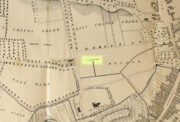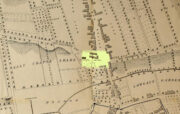Holy Well (destroyed): OS Grid Reference – NO 4007 3046
Also Known as:
- Grey Friar’s Well
Archaeology & History

This is another one of Dundee’s lost holy wells (see also the Lady Well, the Nine Wells, St Clement’s Well, St Mary’s Well and Sinavey Well), around which the town was first built. Its cold fresh waters were located less than a hundred yards north of the old Houff graveyard in the middle of town, or where Alex Maxwell (1884) described as upon “the sunny slopes of the Gray Friars’ meadows.”
Maxwell told us that this sacred site was the most favoured of the the holy wells in the area, having been dedicated to St Francis of Assisi by the monks who built the medieval Grey Friars monastery, whose ruins lie beneath the Houff graveyard. After the destruction of the priory in the 16th century, the holy well and surrounding meadows came under the ownership of the local council. The well had become ruinous and so was repaired back to its old condition, but a few decades later had become very neglected again and was ordered to be closed. It was mentioned in several early land rental documents, including this from 1630 which told,
“That haugh or meadow lying on the south side of the Tentour Hill, and on the east side of the meadow called Monorgan’s croft, togidder with the lands lying about St. Francis’ well, were set for the yearly penny mail of fifty-ane pounds.”
The most extensive description of it came from Alex Maxwell’s own pen, and I reproduce it here in full. He began by speaking of the other holy wells of Our Lady and St. Clement’s in Dundee, but told us that,
“The most important of them was the Gray Friars’ well, which came out of the rising ground westward from where the High School is built, and had been dedicated to the honour of St. Francis, the founder of the order — a man of exalted character, whom Dean Milman calls “most blameless and gentle.” The water, which ran perennially and was of singular purity, had no doubt been highly venerated in the days of the old Church, and it continued to be much esteemed, and even to maintain somewhat of its traditional sanctity, long after the memory of the good man whose name it bore had become forgotten.
“When the Friars’ house was in ruins, and the gardens laid waste, St. Francis’ well did not escape unharmed. One austere iconoclast—James Patrie was his name—had probably been offended at its sculptural reminiscences of the old faith, and he cast it down. When arraigned to answer for this,
“he confest and grantit that he took down the common well callit the Friar well, quhilk servit the haill town with guid and wholesome water, and referrit him in the Bailies’ and Council’s will thereanent; and they being advisit with his offence, declarit that he sail pay for the reparation of the said well and common warks the soum of ten pounds; always, gif he big and repair the well as Weill as it wes of before with lime mortar, or Pasch next, this pain to be remitted; otherwise, the day past and the well nocht biggit, to pay the said soum but favour.”
James, however, proved contumacious; the day did pass, and the well still lay in ruins. But he got further time, for the Council not yet having possession of the monastic lands, had not chosen to act arbitrarily, and
“James Patrie was ordained to repair the Friar well conform to the last act, under the pain contenit thereintil, betwix the date hereof and Whitsunday;”
and he probably then proceeded to restore it into good condition, as we do not find any other ordinance on the matter. He had not, however, erected it very substantially; for, before thirty years had elapsed, the structure was again ruinous, and the Council resolved
“that St. Francis’ well be of new biggit and made close, so that na common access be had thereto.”
“The meadow land of the Gray Friars which lay around the well, formed a pleasant open space for the use of the old burgh, and it was always held in much regard. Early in last century, the water from the Lady well was impounded and conveyed in pipes for supplying other cisterns throughout the town ; but St. Francis’ spring, which was softer and purer, was left undisturbed to flow down the grassy slope in its natural course ; and when the place became appropriated for homely purposes, and upon
“Its verdant braes,
The lasses used to wash and spread their claes,”“the gossiping naiads made the meadow very lively as they plashed in the brimming basins of the Friars’ old well, or filled their pitchers at the fresh fountain, or sprinkled the water in crystal showers over their snowy linen. About the time that the ground was sacrificed for the erection of buildings, a dyer in the neighbourhood sank a well which evidently reached the source of the spring and drained it off. Years afterwards, when the place had been overbuilt, he ceased to use his well, and the stream, returning to its old course, found access into the lower part of a church which now covers the site of the fountain, much to the dismay of the deacons. The water was then carried off elsewhere, and will be seen no more ; and the remembrance of those virtues which belonged to the once famous well will soon have passed away.”
In Christian lore, St Francis’ festival day was October 4.
References:
- Maxwell, Alexander, The History of Old Dundee, David Douglas: Edinburgh 1884.
© Paul Bennett, The Northern Antiquarian
